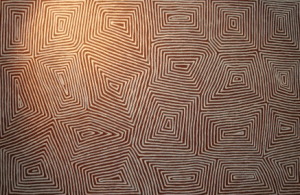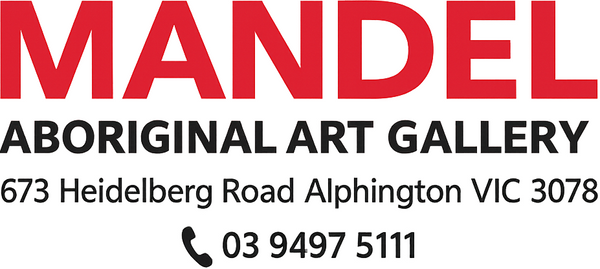
George Hairbrush Tjungarrayi
Share
George Hairbrush Tjungarrayi is a famous Australian indigenous artist, he was born around 1943 at North West of Kiwirrkurra, located in the Gibson Desert in Western Australia. His ‘sisters’ are Naata and Nganngi (Nancy) Nungurrayi both famous aboriginal artists. George Tjungarrayi and his family lived a traditional life until they came out of the western desert region by way of Mt Doreen Station and Yuendumu.
In 1962, George walked to Papunya as a guide for Jeremy Long’s Welfare Branch patrol. In 1971, school teacher Geoffrey Bardon encouraged some of the senior men to paint a blank school wall. George’s ‘uncle’, Charlie Tarawa Tjungurrayi was one of the men involved. The school murals sparked immense interest and is seen as the catalyst of the Papunya art movement and the beginning of the Aboriginal Art Movement. George served as an apprentice artist to the senior artists in the Papunya art community. He was surrounded and encouraged by some of the great artists in the Aboriginal art movement, and in 1976 he began to paint in his own right after encouragement from Nosepeg Tjupurrula, one of the founding artists of the Papunya art movement and a leading identity. Whilst his early works resemble that of some of the great Papunya masters, George soon developed his own distinctive style of dreaming time stories. George has perfected a minimalist and abstracted style of painting that is characterised by transverse parallel lines that pulse with subtle optical rhythm. While there are aesthetic parallels with works created by contemporary Western artists of the Op-art movement, George’s works are based on his country and culture. George’s artworks symbolise ancestral journeys and ceremonial body paint.In particular, George paints the Tingari dreaming stories of his ancestral country which covers the western Australian aboriginal sites and northern territory aboriginal art sites around Kiwirrkura, Lake Mackay, Kulkuta, Karku, Ngaluwinyamana and Kilpinya. Professor Vivien Johnson has also suggested that his striking imagery is drawn from the distinctive Western Desert style of ‘fluted’ carving; fine parallel lines incised into the wood and coated with ochres which embellished men’s ceremonial artworks such as boomerangs and shields.
At Mandel Aboriginal Art Gallery we had an George Tjungarrayi exhibition on Tingari dreaming paintings https://mandelartgallery.com.au/exhibitions/george-hairbrush-tjungurrayi-exhibition-01-jul-14-jul-2016/
Some more than hypnotic art work for sale from George Hairbrush Tjungarrayi, https://mandelartgallery.com.au/artist/george-hairbrush-tjungurrayi/

